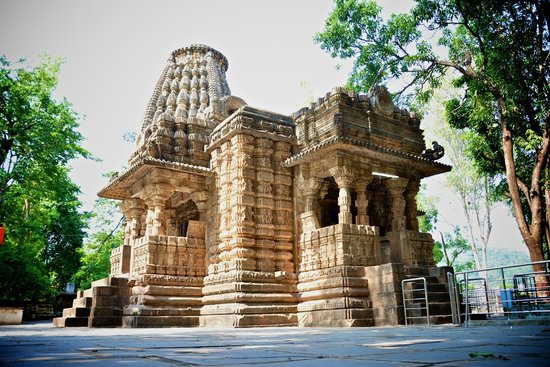
Bhoramdeva temple is one of the
important ancient temples of Central India. It is situated in Kabir Dham
district, 18 km. northwest of Kawardha town. This famous temple of
Bhoramdeva was built in 11th cent. A.D. in Nagar style of temple
architecture full of beauty and grace. It is compared with 'Khajuraho’ and
addressed as 'Khajuraho’ of Chhattisgarh'. According to historical
records, this temple belongs to the Nagvamshi ruler. Located near a
village called Chhapri, in a valley placed among the circular range of Makel
mountains, it rises imposingly to a height of 100 ft. above the ground, and is
a fine example of intricate and exquisite piece of sculpture depicting
beautiful carvings of couples, elephants, horses, dancers (both male &
female), idols of Lord Ganesh, Natraj etc.
The entrance of the sanctum of
the temple is made of shining black stone with beautiful statues around it. The
Shiva Linga in the temple is beautifully carved and the artistic appeal beckons
the visitors. The Bhoramdeo temple has a resemblance with the Sun temple of Konark and
the Khajuraho temple, and that is why it is also called the Khajuraho of
Chhattisgath. With a background of natural beauty, this temple is also unique
for its architecture. Cunningham had termed it as one of the most beautifully
decorated temples seen by him.
The main temple is in front of a
tranquil and cool lake. This medieval temple has been constructed upon a five
feet high sprawling platform including a ‘Mandapa’ and ‘sanctum’ (Garbhagriha).
This east-facing temple has three openings except in the west. In the 60 ft. X
40 ft. area of the temple the Mandap is square shaped having four pillars in
the centre and the rest in periphery and associated with high roofs. There is a
half shelter also on every entrance. In the 9 X 9 Sq. ft. sized ‘Garbhagriha’ a
Shiva Linga’ is installed.
Near the entrance on the outer
walls, the sculptures of Lord Vishnu and his other incarnations can be seen,
besides those of Shiva, Ganesha etc. The row of idols from top to bottom have a
size of one, one-and-a-half, and two feet height respectively. The bottom part
of the temples has four structures to keep the main body of the temple intact
braving adverse wheather conditions. There is no ‘Kalasha’ on the top of the
same. The idols of elephants and lions are queued up on the top to give the
temple a decorative look. The main idols in the temple are those of Uma-Maheshwar,
Natraj, Narsimha, Vaman, Krishna, Surya, Kaal Bhairava, Nritya Ganesh,
Kartikeye, Tandul, Shivgang, Chamunda, Ambika, Sapta-Matrika and Laxmi-Narayan.
The traces of ‘Ramakatha’ are also engraved here on stones. Amidst a variety of
idols the carved eternal sculptures of the temple are known worldwide for their
exquisite carving in different erotic poses, obviously to reflect the lifestyle
of those historic periods.
In the north near this temple, there is a
brick-structured temple. On the north-east and south portions of the
‘Garbhagriha’, the right-angled projections add attraction to the site having
big one in the middle and smaller ones on the outer sides. The brick temple
also has similar square Garbhagriha, as in the main temple but there is no ‘Mandapa’
in the front and only an open projected wall is there, which contains ‘Alinda’.
The entrance of the ‘Garbhagriha’ is completely stone carved having one central
pillar and three adjoining pillars still intact. Inside the main temple, there
are the Sahiva Linga and idols of Uma-Maheshwar. The king and queen are
standing in the front as the worshippers.
Geo-co-ordinates - 22011' N 81015'
E
Period - c. 11th A.D.
Notification
No. F-6-11-82-सं-30 Dt. 24.08.1979